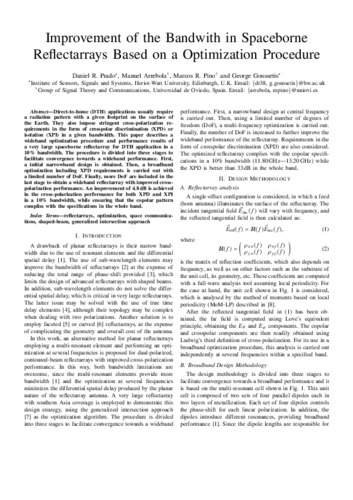Improvement of the bandwith in spaceborne reflectarrays based on a optimization procedure
Autor(es) y otros:
Palabra(s) clave:
reflectarrays
optimization
space communications
shaped-beam
generalized intersection approach
Fecha de publicación:
Descripción física:
Resumen:
Direct-to-home (DTH) applications usually require a radiation pattern with a given footprint on the surface of the Earth. They also impose stringent cross-polarization requirements in the form of crosspolar discrimination (XPD) or isolation (XPI) in a given bandwidth. This paper describes a wideband optimization procedure and performance results of a very large spaceborne reflectarray for DTH application in a 10% bandwidth. The procedure is divided into three stages to facilitate convergence towards a wideband performance. First, a initial narrowband design is obtained. Then, a broadband optimization including XPD requirements is carried out with a limited number of DoF. Finally, more DoF are included in the last stage to obtain a wideband reflectarray with improved cross-polarization performance. An improvement of 4.8 dB is achieved in the cross-polarization performance for both XPD and XPI in a 10% bandwidth, while ensuring that the copolar pattern complies with the specifications in the whole band.
Direct-to-home (DTH) applications usually require a radiation pattern with a given footprint on the surface of the Earth. They also impose stringent cross-polarization requirements in the form of crosspolar discrimination (XPD) or isolation (XPI) in a given bandwidth. This paper describes a wideband optimization procedure and performance results of a very large spaceborne reflectarray for DTH application in a 10% bandwidth. The procedure is divided into three stages to facilitate convergence towards a wideband performance. First, a initial narrowband design is obtained. Then, a broadband optimization including XPD requirements is carried out with a limited number of DoF. Finally, more DoF are included in the last stage to obtain a wideband reflectarray with improved cross-polarization performance. An improvement of 4.8 dB is achieved in the cross-polarization performance for both XPD and XPI in a 10% bandwidth, while ensuring that the copolar pattern complies with the specifications in the whole band.
Descripción:
XXXV Simposium Nacional de la Unión Científica Internacional de Radio (URSI) (35º. Málaga. 2020)
Patrocinado por:
This work was supported in part by the Ministerio de Ciencia, Innovación y Universidades under the project TEC2017-86619-R (ARTEINE); by the Ministerio de Economía, Industria y Competitividad under the project TEC2016-75103-C2-1-R (MYRADA); by the Gobierno del Principado de Asturias/FEDER under the project GRUPIN-IDI/2018/000191; and by Ministerio de Educación, Cultura y Deporte/Programa de Movilidad “Salvador de Madariaga” (Ref. PRX18/00424).
Colecciones
Ficheros en el ítem





